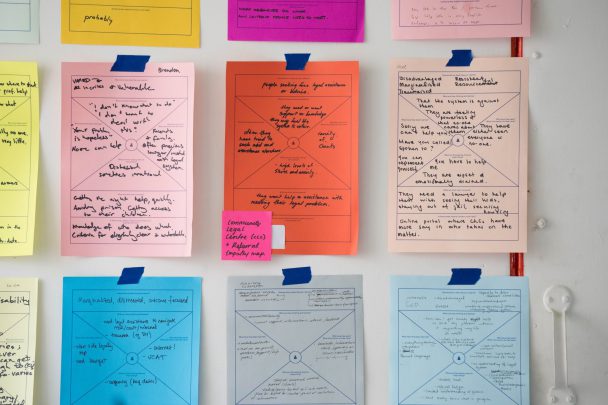Agile Methodologies were born from the need of the market to streamline its processes to create value solutions for customers. Agile puts the user at the center of the development process, enabling the creation of more assertive and less wasteful solution
1. What is the Agile Methodology?

Agile Methodologies are project management models with roots in IT and created based on the dissatisfaction of a number of developers with the lack of fluency of traditional management models. Agile is associated with a productive mindset and is focused on segmenting the scope of tasks to anticipate deliveries, generating a faster customer value perception.
The mechanics of agile application consists in the insertion of the client in the team so that the alignment of expectations with regard to the deliveries is done from the start. Here, agility helps break down complex tasks across multiple checkpoints, making it possible to deliver functional portions of value items consistently, reducing, for example, the customer’s waiting time for the use of a benefit.
Thus, the adaptability of agile makes it ideal for scenarios of uncertainty, such as projects being developed with new technologies or constant changes of direction.
2. Waterfall vs Agile
The Waterfall Model is a classic framework of management processes in software projects. The model was widespread in the past decades and has become very popular in large corporations.
The development phases of the Waterfall model, as it is known worldwide, are requirements analysis, design, implementation, testing, integration and maintenance. The model is rigid and is based on standardized and sequential activities, that is, one step should occur systematically after another, without the scope of parallel work.
Although still widely used when the project presents low risk of delivery and well-defined requirements, with no possibility of scope fluctuation, the Waterfall model is no longer dynamic enough to meet most of the demands of the current market.
Therefore, Waterfall methods have been gradually replaced by modern methodologies such as agile, which gets feedback from customers and produce validation cycles at the end of each step.
3. Agile Methodologies in Business
Although traditional project management methods are still useful, adopting an agile mindset is an increasingly frequent move. Companies such as Coca-Cola, BNP Paribas, and Delta, among others, are in a process of full transformation to incorporate agility into day-to-day work.
The key point of the choice of the adoption of agile methodologies by companies is the increase of team productivity and performance. Agility translates into greater operational flexibility and competitive advantage. The result is a dynamic similar to that of startups.
Among the gains promoted by agile are reduced bureaucracy and micro-management in projects, rapid adaptation to targeting changes, reduction of go-to-market time of a functionality, product or service, as well as elimination of waste through frequent cycles of testing and validation.
However, the shift from the traditional corporate work model to the agile mindset is not a simple transformation and represents a paradigm shift in almost every organization. Its adoption requires a period of acculturation of employees, and the process is usually carried out through punctual and incremental applications.
To help in this process of adaptation, a good alternative is to use agile not only in teams at an operational level, but also in a more structural one, inserting it into the corporate governance model.
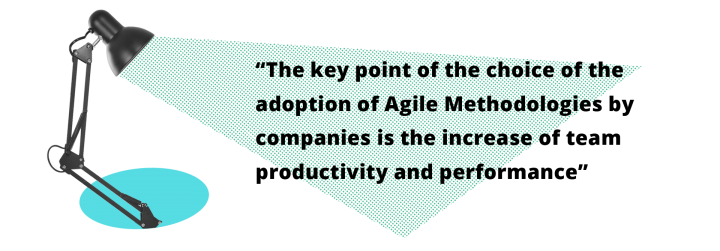
Corporate Governance x Agile Governance
Governance is the epicenter of business functioning. It is the area that regulates policies and strategies to be implemented, defines responsibilities and guarantees the implementation of processes. Its function is to evaluate, monitor and direct, through defined strategies, the management of the whole company.
In this scenario, the term Agile Governance is an approach that blends the attributions of Corporate Governance with the premises of the agile mindset. This combination invites us to adapt in advance to the business challenges.
Companies facing constant changes in their strategic directions are the most propitious to adopt an Agile Governance scenario, used to respond more assertively and in advance to the demands that arise.
The concepts of Governance and Agility may seem contradictory. Governance focuses on controls and responsibilities, while Agile cares for trials. But the union of both approaches makes perfect sense when one understands the importance of building a model of Agile Governance. Some of its points are:
You have to connect departments and people in the same process model to have agile methods running in sync across all levels and departments of a company.
A governance that is active and willing to understand, discuss and provide effective metrics on indicators of agile project management, value added to the business, software quality, documentation and knowledge management for continuous improvement.
Different KPIs need to be defined and analyzed to base strategic decisions. Agile metrics provide strategic data for organizations to make their decisions.
MAnGve (pronounced mangue) is composed of good practices in agile methods directed to the area of corporate management. The model is a set of analogies about sustainable development and its proposal is to allow for the implementation and development of corporate governance, supplying or minimizing the shortcomings of other models.
– Good governance
– Focus on the human being
– Business-oriented
– Based on agile solutions
– Systematic and adaptive approach
– Simple design
– Continuous improvement
4. Marketing
The term ‘Agile Marketing’ is the combination of the Agile concept applied to the scenario of the Marketing teams. Faced with the need to manage actions dynamically in the face of the emergence of new digital technologies and the changes they provoke in different sectors, the traditional model of marketing strategies has been refined
Agile Marketing has emerged as a high-return approach. Some of the most easily measurable aspects of implementing agile in marketing contexts are the greater speed of go-to-market, greater engagement, productivity and motivation of teams, as well as increased delivery quality.
It is common to adopt agile frameworks, such as Scrum and Kanban, in the Agile Marketing scenario. Scrum’s well-defined structure in project management can be a great starting point to start shifting teams to a self-manageable mindset.
On the other hand, Kanban is leaner, but gives more flexibility and adaptability in scenarios with no pre-defined scope.
The combination of Scrum and Kanban is known in agile scenarios because it is strongly delivery and results-oriented. The union is ideal to implement the value propositions of Agile Marketing in its entirety.
Subscribe to receive our updates
Fill the form to receive our freshest content
5. Human Resources
The term ‘Agile’ is no longer used only in the area of Technology. Today, Agile Methods are transforming the way companies hire, develop, and manage their employees.
In the relatively near future, many tasks performed by the Human Resources sector will be overcome. But what comes next?
Agile HR has come to reshape HR, helping create a more resilient organization. The methodology consists in distancing the rules-based approach and planning in search of a simpler and more productive model guided by results.
Since HR affects every aspect of an organization, the transformation can be even more complex than changes in other areas.
Traditional HR focuses on individuals, their goals, performances and needs. And at a time when companies organize their scope of work into projects, management systems are increasingly focused on bringing talent to teams.
The guidelines below are part of the Agile HR Manifesto, and they were created to discover more assertive ways of developing organizational culture.
6. Commercial and Sales
In a dynamic landscape, where customers have acquired new perspectives and desires, the corporate area needs to reinvent itself at all times. Today, most customers do not have the patience to participate in rigid and traditional sales processes.
Adopting business agility adds flexibility the work model, which allows companies to anticipate customer needs and deliver high-value experiences. Once this need was identified in sales and sales departments, Agile Sales was born.
From already proven elements and proven efficacy in IT contexts, such as development sprints, status meetings and open communication, Agile Sales has become an important ally of companies.
The culture of bonus by achieved goals makes the occurrence of individualized work routines in the commercial area common. However, the Agile model has multidisciplinarity as its basic premise: the more specialties the team has, the more functional and conducive to achieving goals it will be.
In this way, the method stimulates good practices, such as teamwork, to achieve the the sector’s goals, a fundamental characteristic of agile teams.
From the goals defined in the commercial area, it is possible to base the Scrum framework, for example, and divide the Product Backlog (task list). From this division, the Sprint Backlog is created, a list of activities to be worked on in each sprint based on the time set for its execution. The ideal duration of sprints should be proportional to the goals set.
However, it is worth mentioning that stipulating short delivery periods will not always meet the reality of commercial departments. Sometimes the life of a negotiation exceeds the 15 days recommended by Scrum for the duration of sprints. Therefore, the window of time for carrying out the tasks in the commercial area should be more flexible.
Download our Agile Sales e-book to see an example of the Agile Sales Model
Agile Sales practices promote significant change in business, giving greater flexibility, scalability, communication and productivity to sales and sales departments. In a short time, it is possible to review and adapt the model of operation of the entire department to the needs of customers.
7. Agile Methodologies: why are they important for your company?
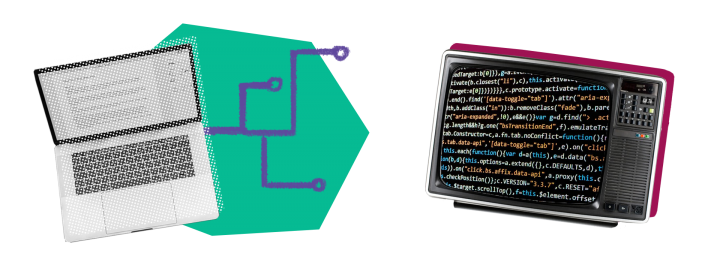
The world is going through the Age of Digital Transformation. And this concept goes far beyond the automation of processes. Recently, the emergence of startups with completely new business models has triggered a revolution in the market capable of changing consumer behavior in the blink of an eye. And consequently, this has given rise to a drastic change in the whole business logic.
Technological evolution has caused an uproar in the corporate world. Today there are companies creating multimillion dollar businesses in sectors such as hotel and transportation without owning any hotels or vehicles. And this has had disastrous consequences for companies that cannot understand their customers’ desires and adapt to this scenario.
Thus, designing solutions that are aligned with customer needs in an assertive manner is the current challenge for large corporations, as well as for small and medium sized companies whose management models are unable to predict these changes in the market or rather, unable to provide guidance to change.
In this race for market leadership – and sometimes for survival – innovative methods and practices are no longer a luxury and become a day-to-day operational necessity. Therefore, many companies are adopting the agile methodology.
The creation of agile mindset not only provides process improvement, but a new strategic guideline for the entire company if it is scaled in a sustainable and convergent way, from development teams to managerial level and vice versa.
Some of the practical benefits of implementing agile methodologies are:
For teams
- More discipline, regularity and autonomy
- Constant monitoring to minimize waste and create cycles of improvement
- Horizontal management and shared responsibility
- Appreciation of the human side of the project
For customers
- Reducing risks and adapting to surprises and changes
- Making aspects of the final result from the first week tangible
- Transparency and visibility of project status
- Flexibility to change requirements
- Deliveries of constant value
- Visibility on commitment and improvement in communication during the process
- Anticipation of problems and greater agility to take actions
8. The Agile Manifesto and Modern Agile
The use of the term “agile” originates in the Agile Manifesto, created by a group of programmers who were troubled by the flaws that occurred during the management of software development projects. From this meeting the Agile Manifesto was born, which describes four important values in the modern process of project management:
- Individuals and interactions rather than processes and tools;
- Software in operation rather than comprehensive documentation;
- Collaboration with the client rather than contract negotiation;
- Respond to changes rather than following a plan;
However, with the increasing adoption of Agile, new interpretations of its principles and practices have emerged, such as Modern Agile. According to its creator, Joshua Kerievsky, this redefinition emerged as an ultra-light version of the Agile Manifesto, whose guidelines often failed to break away from the bureaucratic structures of the corporate world.
Modern Agile does not speak explicitly about development and has a broader view, incorporating its own principles into corporate pillars and culture.
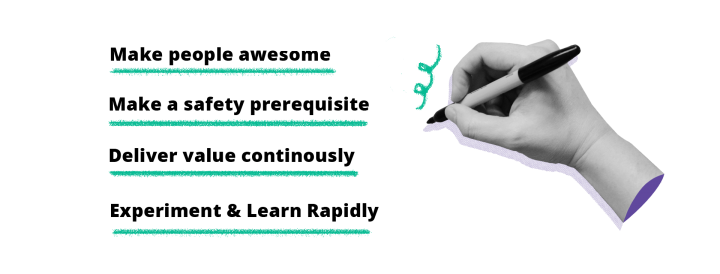
See the definitions of the new Agile values:
This value is about making people feel incredible in their work. By creating an ecosystem where they feel empowered and that takes into consideration the context in which employees are involved, their pains and aspirations, it is possible to create an environment that fosters the development of their full potential.
Security is a prerequisite to unlocking high performance. Establishing high standards in security means actively protecting the greatest assets, not only from customers and employees: time, reputation, financial health and relationships with people.
Learning. It is not possible to empower people to be their best or make safety a pillar if there is no room for learning. In Agile, you learn through experimentation, so projects have a “safe to fail” margin. When there is no such time, the increment of value in development is lower.
Everything that is not delivered is wasted. So how can valuable work be delivered faster? Producing value on an ongoing basis requires large amounts of work to be divided into smaller, yet relevant, parts to be delivered immediately and not later.
9. Agile Framework: what is it and which is the most used?
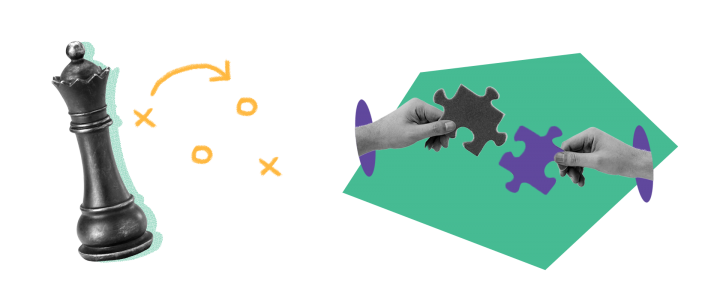
Agile Frameworks are methods that can and should be used as a reference for adopting agility. Through them it is possible to experience the agile mindset in practice.
Adopting these frameworks makes corporate processes more dynamic, staggering business values and productivity. Knowing each one and combining them with other specific approaches allows you to extract the best from each solution.
The following are some of the best-known agile frameworks in the most diverse business contexts: Scrum, Kanban, Extreme Programming (XP), Lean, and SAfe.
What is Scrum?
Scrum is based on the principle of objectivity, well-defined roles, and ease of learning. It uses iteration, a non-linear approach that gives visibility to the problems and serves as a guide for the team. Their practices help the team manage tasks and measure the time and effort required to execute them.
This framework values the interactions between teams and clients, as well as the rapid response and absorption of the changes identified as necessary throughout the
process. The expected result is the increase in the performance of projects and the generation of high value for clients and businesses based on concrete results.
Scrum principles
The main pillars of the Scrum are: transparency, inspection and adaptation. Its main objective is to allow the actors involved in the process to work collaboratively, following the progress of the demands and deciding on the best forms of adaptation. The model proposes a results-oriented approach, through optimization of productivity, continuous improvement and quality of deliveries.
Transparency
All information and activities carried out by the development team that impact the outcome of the process must be known, understandable and available to the entire team.
Inspection
Activities, called Scrum artifacts, are monitored, prioritized, and evaluated periodically in daily meetings. This process allows the company to certify the quality and the time of development, as well as to quickly correct possible deviations and to absorb the necessary modifications.
Adaptation
Upon inspection, if any variances are detected outside the defined delivery scope, it will be necessary to refine the product through agility, adjusting the delivery so that any traces of the problem are eliminated. During the course of the project, feedback meetings are held to evaluate the changeable points and path way to be followed in new sprints, which guarantees better prioritization and reduction of these gaps.
The implementation of Scrum requires three essential roles:
Dev Team (DT)
Multifunctional group or team responsible for analyzing, developing, implementing and testing the product/service.
Scrum Master (SM)
A member of the development team responsible for monitoring team processes or activities, controlling deadlines, removing possible impediments and ensuring rites.
Product Owner (PO)
Member of the team responsible for the project that responds to the business and represents the interests of the clients/stakeholders.
What is the Kanban?
Kanban is a Japanese word meaning “visible sign or board”. The tool originates from the Toyota production system and was designed to provide a complete view of the flow of tasks performed on assembly lines.
Nowadays, it is often used in the corporate world to divide tasks among team members and to give visibility to the scope and those responsible for their accomplishment. The organization is usually done through post-its in columns, obeying an order of tasks to be carried out (to do), “in progress” (WIP) and “done” (done).
Kanban is a great tool to identify bottlenecks and waste, allowing for strong assimilation of information by the team, and it provides clear management, communication and integration increase, guaranteeing greater efficiency in the processes
Kanban principles
Clear management
The stages of production of the product or service are clearly identified.
Adaptive Development
The process of prioritizing deliveries is done according to the value criterion: it is delivered before that which has the highest value for the customer.
Work placements
The production process can be measured and controlled, enabling a cycle of continuous improvement.
Kanban can also be applied by HR companies when hiring employees, in the financial management of the segments of a company, in the potentialization of marketing strategies, in the optimization of IT processes and in the increase of production in industries.
What is the Feature Development Driven (FDD)?
The FDD is a framework oriented to the construction of complex functionalities of a system. As its name indicates, from the planning to the construction of the features, the deliverables are grouped by similarities and technical dependencies.
Feature Development Driven is an iterative, incremental, and lean design management technique. It is specifically useful for development and coding teams and its goal is to produce frequent, tangible and functional results.
Feature Development Driven Principles
The FDD methodology is relatively easy to be assimilated by developers. To work within your concepts, you have to follow five steps:
Development of a comprehensive model
An object-oriented analysis is required to understand the project domain. It may involve, for example, requirements definition, object-oriented analysis, and logical modeling of data.
Building a list of features
This is the time to define all the features that will be built during the project. A functional decomposition is performed, prioritizing the development hierarchically from the best composition for the product.
Planning by functionality
In this step, a development plan is created focused on a specific functionality, always following the order of prioritization. The team should create work packages and estimate these points according to the expected complexity. The goal is to create an incremental delivery schedule.
Production of detailed schemas
The team must define points to be made and tested at a technical level (code). The practical result of this step is the production of an object-oriented design. That is, a functionality flow must be created with a defined structure that is ready to be developed.
Construction by functionality
After planning the product, you need to define the acceptance criteria. It is at this moment that the team develops the planned functionality and increments it with a function with potential of use for the user/client through guided tests
What is Extreme Programming (XP)?
Extreme Programming, or simply XP, is an agile framework focused on the scope of development. The methodology pushes the product/service to the extreme in a set of practices such as testing, reviewing, integrating, simplifying and iterating rapidly to constantly follow project development. XP is recommended for teams that need to work on vague requirements and constant targeting changes.
XP encourages quality control as the main variable of the project and one should not expect the developer to give up quality for other variables. Therefore, team and client must be in tune for feedback to be more assertive.
During the development project, it is highly recommended to prioritize the features that represent the highest possible value for the business. In this way, efficiency can be guaranteed by anticipating changes to reduce costs. If scope reduction really is required, functionalities that are not highly valuable will be deferred or canceled.
Extreme Programming (XP) principles
Extreme Programming is a real value tool for developing projects that require fast targeting changes. XP has a number of principles that optimize production and allows it to run smoothly,. Are they:
Communication
The basic elements of communication are clarity and trust. Therefore, decisions in Extreme Programming are taken as a result of the personal conversation between the work team and the client, eliminating unnecessary documentation. Some of the most effective techniques for exchanging ideas and prioritizing tasks in XP are user stories, on-site clients (CCC), peer programming, and planning poker.
Simplicity
Develop only what will be used, discarding complex commands;
Feedback
Also used in Scrum ceremonies (daily, retrospective and review), feedback is a precursor to Extreme Programming, guaranteeing the full operation of the developed product and the fulfillment of the deadline through tests such as short iterations, increments and releases,.
Courage
The customer must always be aware of the barriers to development, the strengths, and the need for project changes. So, having the courage to be totally transparent about any issues that may arise is key.
Coach
In XP, it is critical that someone be formally responsible for ensuring that staff follow the principles of methodology in practice. In Extreme Programming, the coach assists in the implementation and flow of the framework, monitoring all processes.
What is the Scaled Agile Framework (SAFe)?
The Scaled Agile Framework (SAFe) was a proposal created to transcend the development teams and scale the Agile at the organizational level. Unlike Scrum and Extreme Programming (XP), which are for teams, SAFe is meant for business management as a whole.
The methodology is well documented, providing a complete overview of the business and technical principles to be used to scale the company from top to bottom, meeting the bottom-up evolution of the teams. In this way, SAFe helped expand the agile methodologies market, allowing Lean and Scrum concepts to penetrate the entire organizational structure.
SAFe is based on Scrum and Extreme Programming, and prizes for experimentation. In order to be successful in transforming a company into agile, the approach is to test the practices that have made sense in the teams and to adopt them or not at the management level according to the receptivity. It is not wrong to say that by drinking from so many sources, SAFe absorbs what works best in Agile.
SAFe principles
The Scaled Agile Framework has three levels of implementation:
• Team: which provides a process model based on Scrum and XP for the teams;
• Program, in which the efforts of the teams that already run agile with consistency are integrated to generate greater value for the company;
• Portfolio, the ultimate goal of implementing SAFe, in which the company achieves an Agile degree of maturity and all initiatives are aligned with business strategy and investment intentions.
What is the PDCA?
PDCA is an acronym for “plan, do, check and act”. The acronym defines an iterative cyclical method of process control and refinement in products and services.
Also well known in the context of Lean Modeling, PDCA is used to plan changes, put them into practice, check the effect of the solutions, and implement them. If the effect of the solutions is below expectations, it is common to redo the process to refine the actions taken. The objective is to promote a cycle of continuous improvement
It is a tool based on repetition, applied successively in the processes seeking continuous improvement to ensure the achievement of the goals necessary for the survival of an organization. It can be used in any branch of activity to achieve a better management level every day. Its main objective is to make the processes of the management of a company more agile, clear and objective.
PDCA principles
The principles governing the virtuous cycle of PDCA are, of course, planning, execution, verification, and refinement.
Planning
The mission, tools, objectives and processes necessary to achieve the expected result are established;
Execution
Time of implementation of activities. Often includes mapping data for analysis in the next steps.
Verification
Monitoring and validation of the processes carried out to achieve the objective;
Action
Act as validation and, if necessary, determine new increments to correct failures and improve product quality.
The frameworks provide fluidity in the development of a project, based on organization, planning, transparency and incremental deliveries. It is important to analyze the benefits and characteristics of each one to understand which one or which of them suits the needs of each project or business.
It is also necessary that the routine and the well-being of the team are in harmony so that the processes run well and the principles of each framework are harnessed to their fullest. Everything can be adapted as long as the pillars governing the agile mindset, and each framework specifically, are respected.
What is the Lean Startup?
The current trend in the corporate world is to put aside time-consuming planning and bureaucratic processes to focus on what is imperative to the business. Companies that adopt the posture of inserting the customer at the center of their creative process have reached levels of competitive differentiation that influence the entire industry.
Lean means Lean. That is, in essence, the Lean model aims to understand, identify and eliminate wastes to create a lean, measurable, and continuous development cycle. The framework offers opportunities for improvement for several areas, substantially impacting – and positively – the business equation.
The Lean philosophy was disseminated from the ’70s with Toyota acting in the automotive industry. The model redefined concepts such as productivity, quality and optimization of time and costs in the development of the industry. With an original focus on production, Lean currently guides business development across a range of industries.
Inspired by this idea, American Eric Ries coined the term Lean Startup to represent a business methodology that eliminates waste and increases value production. Through the creation of prototypes (Minimum Viable Product), it is possible to validate functionalities, products or services with customers, identifying market opportunities and intensifying production or redirecting development efforts.
Learn more about the main advantages of adopting the Lean model
Lean Startup principles
The Lean Startup methodology allows for a more agile response to the changes, a characteristic that comes from experimenting with prototypes and constant customer feedback. To get the benefits of Lean and implement the techniques, you need to keep in mind its three pillars:
Customer Development
A continuous process of interaction with the consumer to test and validate their assumptions about customers, product and market through quantitative and qualitative research. That is, in order to discover the concept of value of the product, it is necessary to leave the power of definition in the hands of the client. And the best way to do this is to ask what their demands are, and from that, develop the product or service.
Agile Development
Application of methodologies focused on the individual and able to respond quickly to changes, such as XP and Scrum.
Low-cost technology platform
Reducing costs and waste is a constant in Lean. And to optimize this concept, it is recommended to use free tools (like WordPress, Basecamp, Ruby on Rails, Trello, EC2 etc) that can help to create a good structure of information technology spending little.
The Lean Startup method is known for three great benefits. The first one is the ability to fully control your business through the creation of new business models and products without the need for an investor.
Secondly, the possibility of modifying projects agile when there is the perception that the initial assumptions are incorrect or inefficient. When making early and frequent deliveries, the entrepreneur can identify problems and promote adjustments.
The third significant benefit of Lean Startup is the increase in profit margins by focusing on drastically reducing the initial costs of developing a new product or service.
User Experience and Lean UX
The user experience, also called user experience (UX), can be defined as the sensation that the users of products or services feel at the moment of interaction in terms of usability and/or navigation fluidity through the interface, such as platforms and screens, in the case of digital products.
Usability is, by definition, a quality attribute of the user interface, covering issues such as system difficulty, usability efficiency, pleasant experience, and so on. However, user experience is an even broader concept and includes everything that is related to how users interact with products.
Lean UX
Lean UX is an extremely useful technique in agile projects. Traditional user experience techniques often do not work when development takes place in rapid bursts as there is not enough time to focus on the issue.
Basically, Lean UX is more focused on the design experience and less on results compared to the traditional user experience. It requires a greater level of collaboration with the entire team and its central goal is to get feedback as early as possible to support quick decision making.
Lean Startup + UX + Design Thinking
Even when we look superficially at agile methodologies, it is possible to identify several points of convergence. Lean UX, for example, naturally has a very strong Lean Startup influence. Of course, this integration is no different when we combine agile development with user experience and other methodologies focused on humanizing projects, such as Design Thinking.
Agile
As in agile development, the idea is to deliver functionality as quickly as possible, the four principles of what we call agile development are also assimilated into the Lean UX methodology. They are:
• Individuals and interactions before processes and tools;
• Software that runs over extensive documentation;
• Collaboration with clients exceeds contract negotiation;
• Response to changes in planning
Design Thinking
In Design Thinking, the entire business aspect can be approached with design methods. This gives Design Thinkers the freedom to act in a much broader way when addressing a particular problem.
Design Thinking encourages teams to collaborate between different roles and consider the design product from a holistic perspective. That is, all areas have an understanding of everything that makes sense in the project: developers understand the design and marketing demands and vice versa. Thus, everyone works more synergistically to create the same solution.
In addition, the project approach is iteratively focused on solutions, a feature shared between Design Thinking, Agile and Lean UX. The idea is to deliver small value packages steadily and continue refining the solution until it becomes consistent.
10. Agile Planning Tools
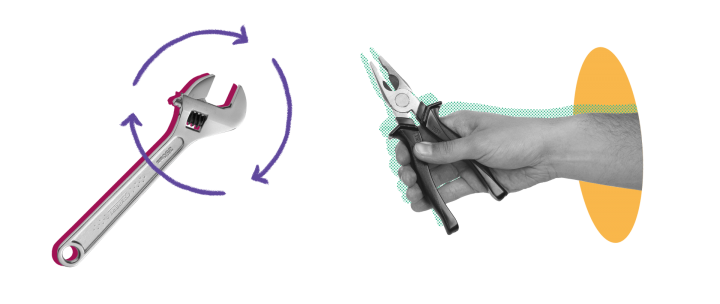
You already know that Scrum is a framework for managing projects from all kinds of demands. But do you know which tools and procedures help you plan sprints for agile teams?
Check out some of the tools of Agil Planning:
Product Backlog
The Product Backlog is the collection of all the user stories of a project and is used to define the scope of a project’s needs, break it into tasks, and direct it to those in charge of development. The operative word here is detailing. Therefore, the product backlog should contain all the stories to be implemented in a prioritized and dimensioned way.
As the project unfolds, the items contained in the backlog must be refined with increasing detail. That is, the items that must be delivered before, must have a higher level of detail than those to be delivered later.
The Product Backlog should be filled with some information, including:
• Unique identifier present on each story card;
• Name of each story card;
• Products resulting from each story (e.g. wireframe);
• Priority of the story (defined by the Product Owner);
• User story points: the estimated effort for each story;
• Sprint: on which sprint the task will be performed
Story Card
Story cards are small cards with specifications about the action to be performed, the professional in charge and the desired functionality. Cards must be described collaboratively by the entire team from the prioritization made by the Product Owner (P.O).
The stories should be short, simple and clear. The lack of space for the specifications in the card means that the user story must be refined and divided into other tasks.
Story cards should be created from the following information:
Story ID: unique identifier number for each story;
Short, objective and clear name;
Description, to be completed according to the following criterion
When __________ (situation), I need/want/should
__________ (motivation) so that it is possible to __________ (result) .
Story priority level;
Estimation from dynamics such as planning poker;
Planning Poker
Planning Poker is a technique used to estimate a team’s effort to perform sprint tasks. Estimates are based on team consensus, balancing opinions to minimize delivery risks.
The definition of Planning Poker occurs through a kind of game. In it, all the members of the team evaluate the effort that they deem necessary to carry out a certain task, from the smallest to the largest.
Based on a relative scaling, for each estimated task, team members defend the reasoning behind their guesses. At the end of Planning Poker, it is possible to get a realistic average of the work effort needed by the team to complete the tasks.


